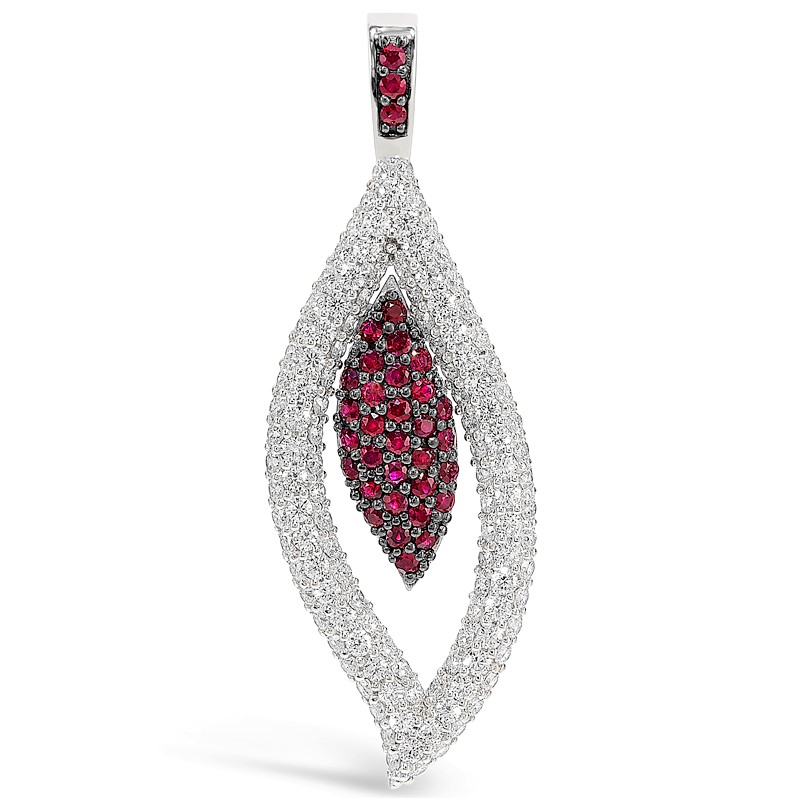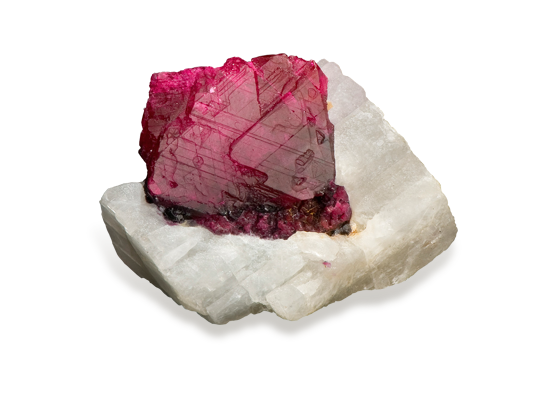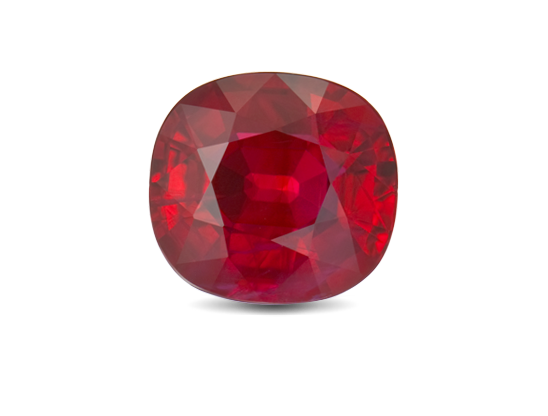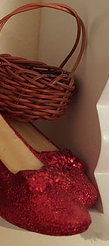The name ruby is derived from the Latin word “ruber” meaning red. No other red gemstone can compare to the intense, rich hues of fine ruby. Its fiery red color is closely linked to the heart and deep love. Being the color of blood, ruby also symbolizes great courage. Revered by many cultures, ruby was believed to burn with an inextinguishable internal fire, signifying immense passion. One of the most coveted of gems, ruby is often referred to as ‘the king of gemstones’. Few things catch the eye like this vibrant gem which, for millennia, adorned many royals.
Ruby is the most rare and valuable variety of the corundum mineral species, which includes sapphire. Ruby gets its color from trace amounts of the element chromium. The more chromium, the stronger the red. Ruby’s finest color is a deep red with a hint of purple, called “pigeon’s blood” in the gem trade.
July’s birthstone, ruby is also recognized as the traditional gift for the 15th and 40th wedding anniversaries. If you were born in July, like our granddaughters Winnie, Greta and Madeline, and are looking for birthstone jewelry, or if you just love ruby jewelry, click the link to browse the current 100 East Fine Jewelry Ruby Collection. Some of our recent designs include this outstanding ruby piece:

History and Lore
Ruby was first discovered in India more than two thousand years ago. Myanmar (formerly known as Burma), is one of the oldest recorded sources of fine ruby. For more than five centuries, Myanmar’s legendary Valley of Rubies (the Mogok Valley), a place of weathered marble and ancient Buddhist temples, produced the best quality and most desirable rubies. Typically forming in marble, these rubies possess an intense red color which typically fluoresces red under ultraviolet light. Fluorescence can make a ruby’s color even more intense and increase its value. These Mogok Valley gemstones set ruby quality standards for centuries. Relative to other gems, Burmese ruby has always been scarce, but in recent decades output from Myanmar has declined further.
Thailand became a major center for ruby trade starting in the 15th century. For many years, deposits along the border between Thailand and Cambodia were the major source of rubies in the marketplace. Thailand remained a major supply point until the 1980’s, when its deposits were essentially depleted and mining ceased. Thailand remains a major cutting and trading center.
Ruby was the prized possession of emperors and kings throughout the ages. Ancient Hindus referred to ruby in Sanskrit writings as “ratnaraj” or “king of precious stones” because of its rarity, hardness, beauty and seemingly mystical powers. Long associated with the life force of blood, ruby was a symbol of power and youthful energy. Rubies are celebrated in the Bible as the most precious of all gemstones. Throughout human history, rubies have been a symbol of passion, courage, love, and romance that endures.
Ruby’s inner fire has also been the inspiration for innumerable legends and myths. Some believed it could predict misfortune or danger. Others claimed it cured inflammatory diseases and soothed anger. Ancient Burmese warriors used to set rubies into their flesh, believing the stone would bring protection and power in battle. Medieval Europeans maintained that rubies bestowed health, wisdom, wealth and success in love. Ruby was said to bring to light the electrifying personality of those who wear it. Wearing a fine red ruby was also believed to bestow good fortune on its owner - although the owner must have already had good fortune enough to possess such a rare and beautiful gemstone! Ruby was recognized as a talisman to ensure harmony, guard against sorrow, inspire confidence and bring success.
Fun fact: The first laser was created in 1960 using the red fluorescence light emitted by ruby.
Use in Jewelry Today
Ruby and its sister gemstone sapphire, are among the hardest of all gems, second only to diamond. Ruby’s durability and hardness make them ideal for all types of jewelry, especially rings and bracelets. Because of its rarity and small size, many ruby jewelry pieces are set with small gemstones.
Ruby has become a popular choice for engagement rings of brides wanting to express their individuality.
While ruby is more durable than many other gemstones, for simplicity, we recommend a single, safe method for cleaning all your gemstone jewelry. A gentle solution of warm water and gentle dish detergent safely cleans ruby jewelry. For additional details, please read our blog Cleaning Fine Gemstone Jewelry. To learn about caring for your fine jewelry, please read our blog Caring For Fine Gemstone Jewelry.
Ruby Color Characteristics
A member of the same mineral species as sapphire, ruby comes in just one hue, red. Ruby’s potential color range runs from orangy red through strongly purplish red in medium to dark tones. The dominant color must be red.
The most significant factors affecting ruby’s value are color and size. The finest rubies possess a pure, intense and consistent red to slightly purplish red color which must be neither too dark nor too light. If the color is too dark, it negatively affects the stone’s brightness. At the other extreme, if the color is too light, the stone may be considered a pink sapphire, even if color strength or intensity is high.
What’s the difference between ruby and pink sapphire? There is no simple answer because of differences of opinion among members of the gem trade. As noted earlier, the word ruby is derived from the Latin word for red, which technically includes pink. However, cultural differences influence the determination of ruby versus pink sapphire. In some gem-producing nations, pink colors were always considered ruby, while in some consuming countries it is classified as pink sapphire. GIA’s laboratory grades ruby on the principle that red must be the dominant hue before a stone can be called a ruby. In the gem trade, though, pinpointing the dominant hue can also be subject to interpretation.
Additionally, fluorescence, which is known to intensify ruby’s red color when the stone is exposed to ultraviolet light, can add to a ruby’s value. Fluorescence can make a ruby appear to glow an intense red; making it appear almost ember-like.
Members of the trade expect rubies to contain at least some inclusions since inclusion-free rubies are practically nonexistent. The prominence and location of the inclusions can affect ruby’s value. Obvious inclusions, or inclusions that reduce transparency or brightness, lower a ruby’s value dramatically. If large and prominent inclusions are located under the table facet, they greatly diminish the stone’s transparency, brilliance, and value. Ruby’s durability can also be negatively impacted by some inclusions, such as significant surface-reaching fractures.
On the other hand, some inclusions actually improve a gem’s appearance. The presence of rutile silk can cause light to scatter across facets that might otherwise be too dark. This adds softness to the color and spreads the color more evenly across the ruby’s crown. Intersecting rutile silk needles can also cause a star effect, called asterism, when the stone is cut as a cabochon.
Commercial quality rubies are commonly available in a wide range of sizes. The per-carat price of ruby increases dramatically as its size increases, especially for better-quality stones. Rubies over 2 carats are rare. In sizes above 3 carats, rubies are extremely valuable and more rare than comparably sized diamonds. The price of fine-quality rubies rise significantly as size increases.
Ruby can command the highest prices of any colored gemstone, with the per-carat prices of fine-quality gemstones repeatedly breaking auction records. On May 12, 2015, the 25.59 carat Sunrise Ruby set in a ring by Cartier established an auction record for a colored gemstone when it sold for $32.4 million (over $1,266,000 per carat). Fine quality Burmese rubies are affordable only to wealthiest of gem buyers.
Ruby Treatments
Many gemstone varieties and species are commonly enhanced to improve their appearance and value. For more detail on gemstone treatments, please read our blog Gemstone Treatments/Enhancements Explained. Some procedures have been used for centuries, while others were developed more recently. 100 East Fine Jewelry along with other reputable dealers disclose any and all gemstone treatments to customers before purchase, so they can make an informed decision. The Federal Trade Commission also requires disclosure of treatments that affect a gemstone’s perceived value. Before you buy, if the dealer doesn’t volunteer the information, always ask if your ruby was treated and by what method. A GIA Identification Report will help you identify if a particular stone is natural or synthetic and whether it has been treated in any fashion.
Perfect rubies are rarely found in nature, which means most are treated in some manner. Coming out of the ground, ruby is routinely enhanced by traditional heating methods to improve both its clarity and color. The process can remove “silk” (tiny needle-like inclusions) in order to make a ruby appear lighter in tone. However, heating will only improve the color if the gemstone already possesses a certain chemistry. Heat treatment is stable under normal conditions of wear and care and therefore considered a permanent enhancement. In the jewelry industry, it is assumed that rubies have been heat treated unless otherwise specified.
Around the turn of the 21st century, rubies began to receive a new treatment, known as lattice diffusion. In this treatment, ruby is heated to high temperatures in an atmosphere containing the element beryllium. Beryllium’s atoms are small enough to completely penetrate ruby’s atomic lattice and change or accentuate its color. Lattice diffusion is extremely difficult to detect except by certain qualified laboratories and is considered permanent. Lattice diffused rubies are considered widespread within the trade and require no special care.
Cavities and surface-reaching fractures cause a significant loss of clarity in rubies. Two related treatments were developed to improve transparency of these stones. One is treating the ruby with oils or dyes. Another is fracture-filling with colored lead glass. These fracture filling techniques can improve not only the clarity but also the color. Neither treatment is considered permanent and require special care.
Despite all the best efforts of gemstone merchants to use technology to enrich color, fine ruby is still exceptionally rare. Rubies, whether enhanced or not, remain among the most durable of gems.
Formation, Mining and Cutting
As mentioned earlier, ruby and sapphire are members of the corundum mineral species. Ruby is formed when colorless corundum is subjected to extreme heat and pressure causing some of corundum’s aluminum atoms to be replaced by chromium atoms; thus creating the red color. However, the presence of silica prevents this atomic level exchange from occurring. Since silica is very common in the earth’s crust, the proper conditions for ruby formation is quite rare.
Ruby is currently mined in Myanmar, Vietnam, Sri Lanka, Tajikistan, Afghanistan, Pakistan, Madagascar, Mozambique, Kenya, Tanzania and Greenland. The US states of North Carolina and Montana also have small deposits.
New production from the historic Myanmar sources is greatly diminished. Some now believe the remaining life of the Mogok deposit is between 10 and 20 years.
In the late 20th and early 21st centuries, important ruby discoveries occurred in Vietnam and East Africa.
- Vietnam has become a significant ruby source, producing many fine rubies of red to purplish red color.
- Important ruby discoveries were made in East African countries of Madagascar, Tanzania and most significantly, Mozambique. Although first known for lower grade material, today Mozambique is home to prolific mines at Montepuez. The market is receiving steady supplies of Mozambique ruby, including increasingly large numbers of fine quality material. Some rubies found there have been compared to the famed Mogok gems.
Another ruby source worth noting is Greenland. Although the source has been known for decades, supplying material to the global market has been a slow process. Responsibly sourced Greenlandic ruby is enjoying a warm welcome within the industry. Although much of the initial production was commercial quality and opaque, a sizeable quantity of better quality material is now available. At some of the more recent AGTA Tucson GemFairs I attended, Greenland has been promoting their rubies, as seen in the following photo I took.

Ruby rough is very expensive, causing cutters to try to conserve as much weight as possible. Several factors affect the cut and proportion of rubies on the market. A ruby’s crystal shape dictates its suitability for certain cuts. Below is a ruby crystal contained in marble. Photo credit to GIA.

The most common crystal shape is a flat tabular hexagonal shape. These crystals might be fashioned into shallow stones, even though light escapes through flattened pavilions, causing an unattractive see-through area in the stone called a window.
Ruby
crystals from some sources can be elongated. To accommodate these crystal
shapes, the most common shapes of faceted rubies are ovals and cushions, with
brilliant-cut crowns of kite-shaped and triangular facets, and step-cut
pavilions with concentric rows of rectangular or square facets.
Round, triangular, emerald-cut, pear, and marquise
rubies are also available, but are rare in larger sizes and higher qualities.
Many fine rubies are commonly fashioned as mixed
cuts, with brilliant-cut crowns and step-cut pavilions. Below is a polished ruby gemstone. Photo credit to GIA.

Famous rubies
Famous ruby gemstones, crystals and jewelry include:
Carmen Lucia Ruby – a 23.10 carat ruby considered one of the world’s largest and finest faceted Burmese rubies is set in a platinum ring with diamonds. This Mogok Valley ruby is currently in the collection of the Smithsonian Institution, having been donated by philanthropist Peter Buck in memory of his wife Carmen Lucia.
The Sunrise Ruby – described in the “Use in Jewelry Today” section
Richard Burton Ruby – an 8.24 carat ruby surrounded by eight diamonds and mounted in a ring by Van Cleef & Arpels was given to Elizabeth Taylor by Richard Burton in 1968. It sold for $4.2 million in 2011, a record per carat price at the time.
Harry Winston Ruby Slippers – to commemorate the 50th anniversary of The Wizard of Oz, Harry Winston created slippers set with 4600 rubies which total apprroximately 1350 carats. The slippers also contain an additional 50 carats of diamonds. The pair of slippers is reportedly valued at $3 million.

Hixon Ruby Crystal – the 196.10 carat Hixon Ruby Crystal is considered one of the most perfect large ruby crystals in the world. Donated to the Natural History Museum of Los Angeles by Frederick C Hixon in 1978.
Nawata Ruby Crystal – the 496.50 carat Nawata Ruby was mined in the Mogok, Myanmar mining area in 1990. It is considered a national treasure of the Union of Myanmar.
Credit the Gemological Institute of America, The American Gem Trade Association and Gemworld International
